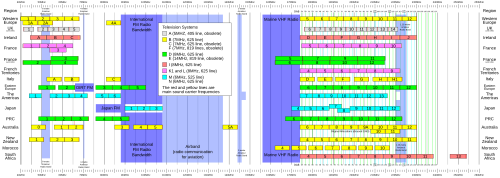
CCIR System D is an analog broadcast television system used in Bulgaria, Latvia, Lithuania, Poland, Romania, Slovakia, Czech Republic, Hungary, Albania, and the People's Republic of China, Mongolia, Kyrgyzstan, North Korea, Tajikistan, Turkmenistan, Uzbekistan, Armenia, Azerbaijan, Georgia, Kazakhstan, Moldova, Russia, Ukraine, and Belarus paired with the PAL/SECAM colour. [1] [2] [3] [4]
Contents
Initially known as the I.B.T.O. 625-line system this was the first 625-line system, developed by Mark Krivosheev in 1948, [5] [6] and later associated with the SECAM and PAL color systems. Used on VHF only in most countries, it usually combined with System K on UHF. In China, it is used for both VHF and UHF. [7] [8]
